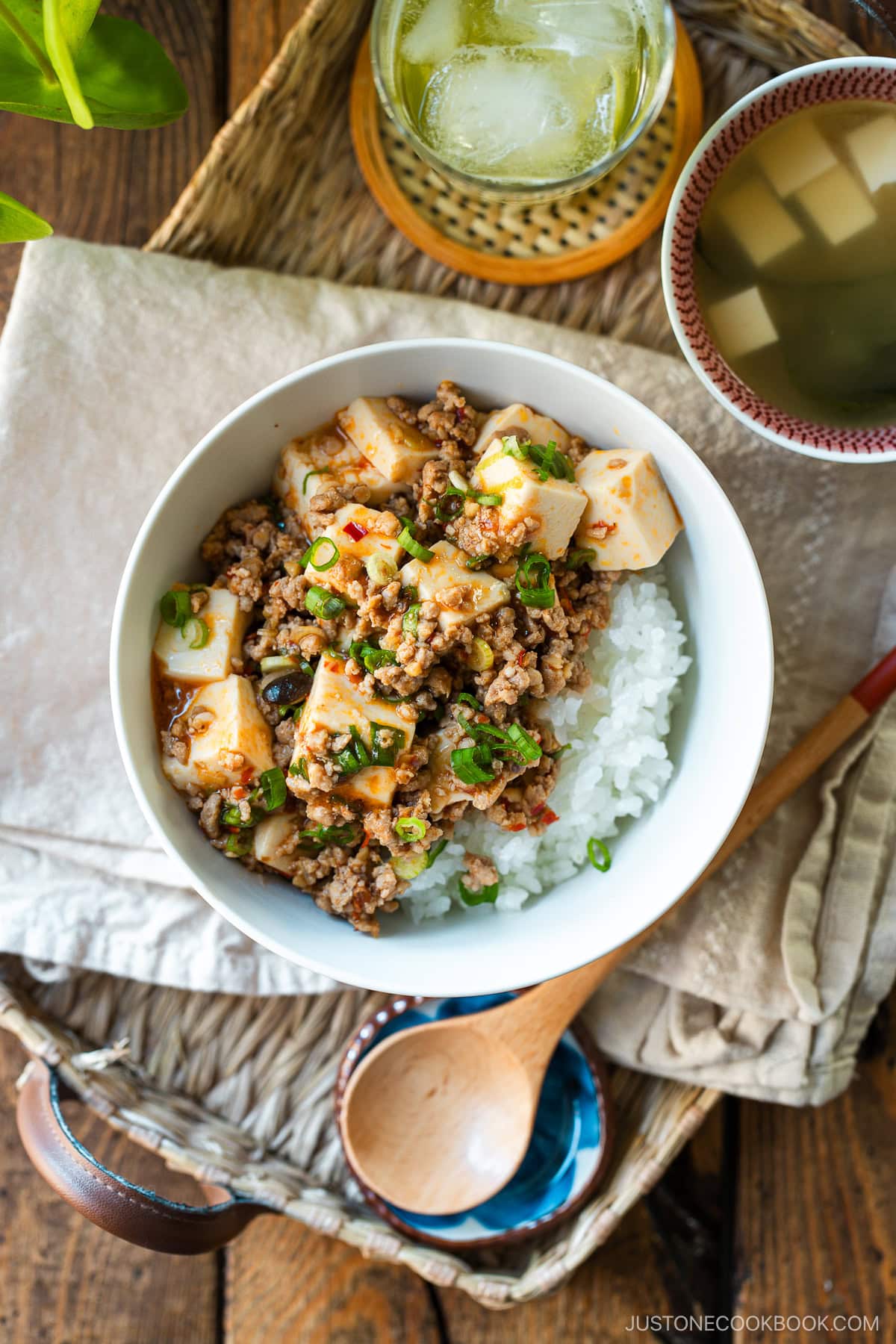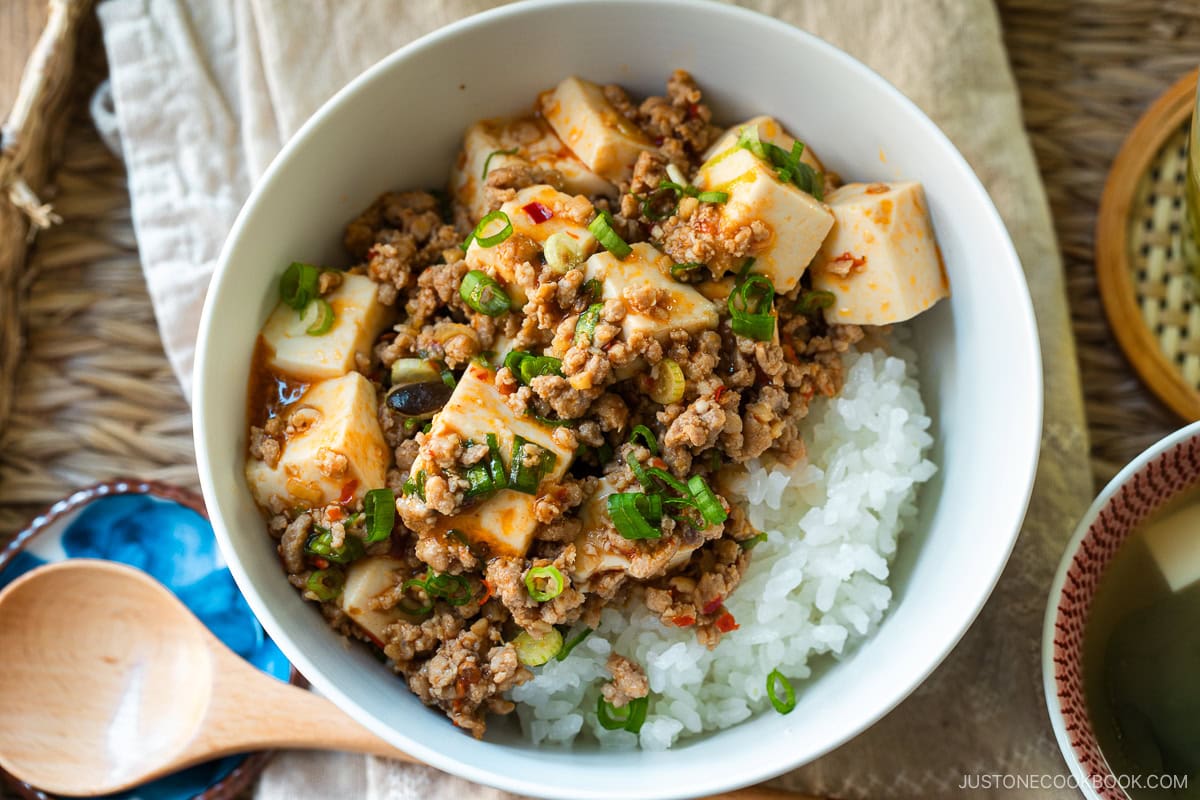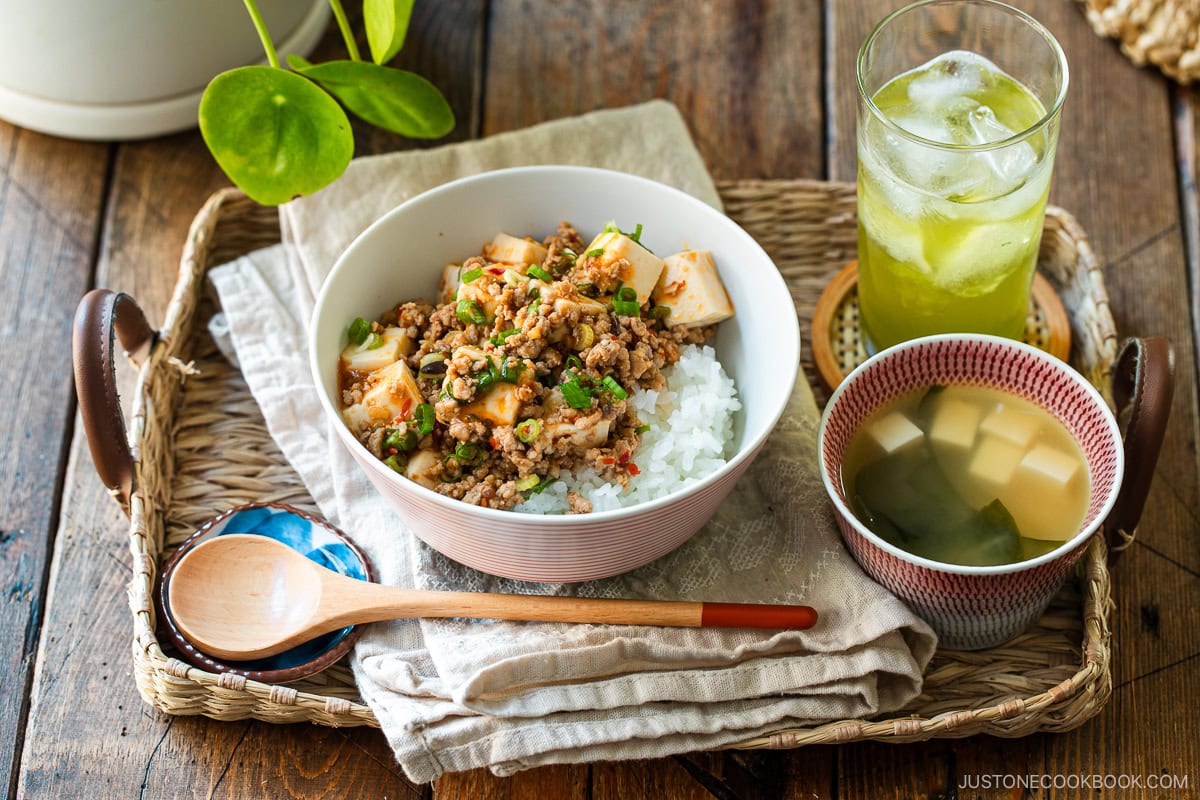Quick and easy Japanese-style Mapo Tofu will satisfy you on a busy weeknight! This popular, homey dish features silken tofu and ground pork in a rich and savory sauce that goes perfectly with hot steamed rice.
One of my son’s favorite dishes in our Easy College Meal Series is Japanese-style Mapo Tofu. When served over hot steamed rice, the mapo tofu makes for a hearty, one-bowl dish. This is another foolproof, comforting recipe that you can cook in just 10 minutes!
If you enjoy Japanese-style Chinese recipes like this, try my Gyoza, Chashu, and Japanese Fried Rice!

In this recipe, we cook the silky-soft tofu in a rich, mildly spicy, and savory sauce and add a small amount of ground pork to enhance the flavor. It’s so delicious that you’ll be proud you made it yourself, without giving in to takeout.
Why I Love This Recipe
Japanese-style Mapo Tofu is an adaptation of the original Sichuan mapo tofu known for its bright, fiery, and intensely spicy red sauce. The Japanese version is milder yet still rich in umami flavor. It’s suitable for everyone, especially those who prefer a less spicy dish as it’s easy to adjust the spice level to taste.
- Quick and easy! The ingredients and cooking process are more streamlined than my standard recipe. Since we’re using an electric pot, cleanup is relatively easy, too.
- Hearty and healthy! It’s delicious, healthy, and packed with protein!
- Easily customizable. The recipe is vegetarian/vegan-adaptable and I’ll show you below for how to adapt it to suit your needs.

Ingredients for 10-Minute Mapo Tofu
- Soft/silken tofu
- Ground pork
- Ginger
- Garlic
- Green onions/scallions
- Sauce:
- Doubanjiang (spicy or non-spicy broad bean paste) – This fermented seasoning adds an authentic and deeply savory character. Without it, the dish won’t taste the same.
- Oyster sauce
- Soy sauce
- Miso – unique to Japanese-style mapo tofu
- Mirin – unique to Japanese-style mapo tofu
- Toasted sesame oil
- Potato starch or cornstarch
Find the printable recipe with measurements below.
Jump to Recipe
Substitutions
- Tofu: I recommend using soft tofu since it adds a smooth and creamy texture to the dish, but you can use medium tofu if that’s what you have.
- Doubanjiang: I personally use the Taiwanese brands Lian How (岡山) or Ming De (明徳) that have a milder heat level. If you can’t find these brands, some people recommend using gochujang (spicy Korean chili paste) or doenjang (non-spicy Korean soybean paste). I haven’t tried them before, but these will alter the flavor profile. For spicy Sichuan doubanjiang, check Amazon or other online Asian markets.

How To Make This Easy Mapo Tofu
Preparation
Step 1 – Prep the ingredients before you start cooking. This dish cooks quickly! I strongly recommend that you measure and mix the sauce ingredients and cut the aromatics and tofu ahead of time.

Cooking
Step 1 – Cook the aromatics and meat together. Sauté the garlic and ginger until fragrant, then cook the pork until it’s no longer pink.

Step 2 – Add the sauce and simmer. Cook and stir until the sauce bubbles and thickens.

Step 3 – Add the tofu and green onions. Coat the tofu with the sauce until the flavors infuse. Then, add the green onions.

Step 4 – Serve. Spoon the dish over steamed rice in a bowl to enjoy it donburi-style.

Nami’s Recipe Tips
- Measure and cut all the ingredients before cooking starts.
- Combine all the sauce ingredients in a small bowl. I always give it a quick stir just before adding it to the pot.
- Drain the tofu ahead of time for about 15 minutes. This prevents the tofu from releasing extra moisture into the sauce.
- Be cautious not to burn the garlic and ginger when stir-frying. You don’t want to add a burnt, bitter taste to the sauce.
- Carefully stir the tofu: Soft tofu can easily break and get mushy. Gently coat the tofu with the sauce, minimizing spatula action.
Variations and Customizations
- Change up the meat. Ground pork is standard in Japan, but you can substitute it with ground turkey, chicken, or beef.
- Make it vegetarian/vegan. Instead of meat, use finely diced fresh or dried (rehydrated) shiitake mushrooms. Use vegetarian stir-fry sauce in place of oyster sauce.
- Adjust the heat level. Add more or less doubanjiang, use the non-spicy version, or turn up the heat with fiery Sichuan doubanjiang!
What To Serve with Mapo Tofu
- As a rice bowl – If you serve it donburi-style (mapo tofu over rice), I suggest adding Homemade Miso Soup and a simple veggie side like Japanese Cucumber Salad to make it a complete meal.
- As the main dish of an ichiju sansai meal – For a Japanese-style “One Soup Three Dishes” meal, serve the rice and mapo tofu in separate dishes, then add a miso soup, two side dishes, and a small dish of Japanese pickles.

Storage and Reheating Tips
To store: Once the mapo tofu is cooled to room temperature, store the leftovers in a glass airtight container in the refrigerator for up to 3 days.
To freeze: I do not recommend freezing this dish as tofu changes its texture once frozen.
To reheat: Gently warm up in a saucepan over medium-low heat until thoroughly heated.

Frequently Asked Questions
For Japanese-style mapo tofu, I recommend the Taiwanese brands Lian How (岡山) or Ming De (明徳) that have a milder heat level (more brown color) compared to the authentic Sichuan taste (more red color).
Wrap a paper towel around the silken tofu and set it on a plate or tray to drain the moisture for about 15 minutes. Be gentle when handling since silken tofu is very fragile. Do not press the tofu because it will crumble easily.
More 10-Minute Easy Recipes
To learn how to cook simple, fast, and affordable meals using a versatile electric pot, check out some of our 10-Minute College Meal Series below:


For the Rice Bowl (optional)
Prevent your screen from going dark
-
Gather all the ingredients. Before you start, drain the tofu for 15 minutes. Simply wrap it with a paper towel and set it on a plate or tray to drain. I use an electric pot for this recipe and others in the 10-Minute Meal series. You also could use a regular saucepan on the stove.
To Mix the Sauce
-
In a bowl, combine the sauce ingredients: 1 Tbsp doubanjiang (spicy chili bean paste), ½ Tbsp oyster sauce, ½ Tbsp miso, 1 tsp soy sauce, 1 Tbsp mirin, ½ tsp toasted sesame oil, ½ tsp potato starch or cornstarch, and 2 Tbsp water. Stir with a whisk until smooth.
To Prepare the Ingredients
-
Thinly slice 1 green onion/scallion. Set aside a bit for garnish.
-
Cut ¼ block soft/silken tofu (kinugoshi dofu) into small cubes.
-
Peel and mince 1 inch ginger. Mince 1 clove garlic (I use a garlic press).
To Cook
-
Turn on the heat to medium-high on the stove or Mode II (600W) on the electric pot. When it’s hot, add 1 Tbsp neutral oil. Add the ginger and garlic to the hot oil and sauté until fragrant; do not let it burn.
-
Add 4 oz ground pork and break up the chunks of meat with a spatula. Cook until the meat is no longer pink.
-
Give the sauce mixture a final stir, then add it to the pot. Simmer and stir to combine with the meat and thicken the sauce.
-
Once the sauce is bubbling, lower the heat to medium or Mode I (250W). Carefully add the cubes of tofu to the pot.
-
Coat the tofu with the sauce by shaking the pot as you stir gently. This will minimize breaking the tofu. Now, add most of the green onions, setting aside some for garnish.
-
Cover with a lid and let it simmer for a minute. Do not overcook as the tofu’s texture will change.
-
Turn off the heat and transfer to individual bowls. Here, I serve it donburi-style over hot steamed rice.
To Serve
-
Garnish with the remaining sliced green onions. You can serve the mapo tofu over steamed rice in a one-bowl meal with a side of soup, or serve the rice and mapo tofu in separate bowls in an ichiju sansai meal.
Calories: 630 kcal · Carbohydrates: 80 g · Protein: 21 g · Fat: 23 g · Saturated Fat: 5 g · Polyunsaturated Fat: 5 g · Monounsaturated Fat: 11 g · Trans Fat: 0.03 g · Cholesterol: 41 mg · Sodium: 1018 mg · Potassium: 383 mg · Fiber: 1 g · Sugar: 4 g · Vitamin A: 218 IU · Vitamin C: 2 mg · Calcium: 40 mg · Iron: 6 mg




